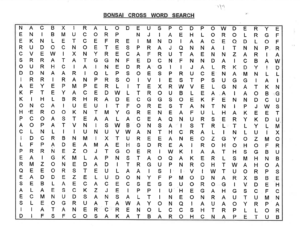- Once plants have leafed out it is time to start fertilizing. See the guide below that Larry Magee gave us last year and use a calendar to record when you fertilized and …
- Wire cutting can happen very quickly during the spring, so check at least weekly. The apex – it’s always growing much stronger than the rest of the tree and thus thickens much faster. Any place that you made sharp bends. The more the tissue is damaged, the more repair that is needed and that is where it thickens the most. Small wire on a branch with larger wire. This one is trickier. Since you have large wire on a larger branch, you don’t always notice how tight the fine little wire is, like a tourniquet, strangling the tree. Since it is fine, it buries itself deep very quickly.
- Watch deciduous trees in the spring – they are elongating rapidly and the negative effects of even the slightest scarring can take a while to mitigate. Watch your conifers in the fall, when they are literally bulking up, storing up reserves for the winter.
- Always remove wire in the same order that you put it on. That means starting with all the fine wire on the tips of a main branch, then working back up the branch, gauge by gauge. That way the branches are supported as you unwind.
- Remove fine wire by unwinding it. I unwind everything up to about 14 gauge, then I get out the wire cutters somewhere between 14 & 12. Two reasons. The first being that you will always miss some of the fine wire if you don’t keep it in one piece by unwinding. The second is that you risk actually cutting the branch off with fine wire. The bottom line is to always use the method that will cause the least amount of damage to the tree. Be ABSOLUTELY SURE to support the branches just as you did when you applied the wire. Remember, especially with copper that work hardens, the wire is twice as strong as when you put it on. If you are not careful, it will just rip a branch right off, no questions asked.
- To remove deeply embedded wire, unwind it as much as you can, retracing the steps you made when you put it on. This may require you to cut it after each revolution. On completely buried wire, I sometimes cut one end short, making sure it is as straight as possible, then pull it through the other side.
- If you have developed trees, this is the time to start pinching. (If you need a review, check the guide below)
- Lastly spring is a time that plants consume a lot of water as buds swell and leaves are formed. This is also one of the hardest times to water as all trees do not come out of winter dormancy at the same time, check each plant to see if they need to be watered. When in doubt use a chopstick to determine how much moisture is below the top few centimeters of soil. Insert the chopstick into the soil and leave it for a minute, if it comes out damp you’re good, if not water. (Also pay attention to the species and the species’ individual water needs.)
——————————————————————————————————————————-
Larry’s Fertiliers and Fertilization Schedule (5/4/2022)
Organic | Inorganic | Supplements |
Biogold | Osmocote Plus | Liquid Kelp |
Sumo Cakes | Miracle Grow | Kelp Fish Mix |
Rapeseed Cakes Green King | Miracid | Humic Acid |
Dr. Earth | Dynagrow (7-9-5) | Rhizoblast |
Bone Meal (Phosphorus) | Root Ruckus | |
Blood Meal (Nitrogen) | KLN | |
Fish Emulsion | SuperThrive | |
Great White | ||
Spring: Late March all trees get a drenching of organic consisting of Hunic Acid, Rhizoblast and some Fish/ Kelp Combo.
Early April Osmocote Plus and some Light Dynogrow are applied to Junipers, Spruce, and Double Fluch Pines. Weekly root drenching and foliar feeding with Humic Acid and Rhizoblast with some Great White added to the sprayer. (Jason uses SuperThrive spray of my Juniper foliage)
Deciduous trees will still not be fed other than the Humic Acid and Rhizoblast to control excess elongation
Summer: Osmocote Plus is applied to all evergreens and on deciduous after the second flush is hardening off. Tea bags of the appropriate organic fertilizers or Biogold are applied monthly starting in June and changed monthly till fall on all trees. Weekly drenching and foliar feeding with kelp/fish mixture and humic acid continue.
——————————————————————————————————————————
Fertilization for Bonsai by Jason Davids
Plants require 14 essential nutrients for healthy growth. Having too little or too much of any of these nutrients in the soil can limit plant growth. Most commercial fertilizers will list the main three macronutrients that plants need, N-P-K. (Nitrogen, phosphorus, and potassium) Fertilizer is usually applied in two different methods depending on the plant and your goals, applying fertilizer to the soil and foliar feeding, spraying the foliage/leaves of the plants. When we water our Bonsai to the point that water flows out of the plants, we are also flushing excess nutrients and waste out of the pots.
———————————————————————————————————————–
Pinching!!!
When it comes to spring growth on our trees, we have several choices on how to handle it. The first is do nothing. Let your tree grow. You might want to do this if you are propagating stock via seeds, cuttings, etc… Or you might be trying to increase the tree, or more specifically, trunk mass. Or we might be growing a single flush, long-needle pine (Ponderosa, White Pine) and if we pinch or prune, we can cause excessive needle elongation. Maybe you are just trying to get a tree healthier and stronger. Whatever the reason, doing nothing at this time of year is a valid technique. The other things we can do are pinching and pruning.
When I think of pinching, the very first tree that comes to mind is a Japanese maple and by the time you read this, we are likely past the first flush of growth, or it is happening now. The idea behind pinching is to remove the central shoot and by doing so we control the strength of the shoot and prevent it from elongating. Pinching controls the inter-node length. It mostly stops elongating once you pinch it. If you miss that window, then you have to fall back on pruning techniques, and if has gotten too long, you have to prune off all that you gained so that you can regrow a piece of ramification to the desired length. And if you are like I was last year and miss that window over and over, pruning again and again, the result is a knob that then has to be pruned off even farther back.
Image of what you are looking for when pinching a deciduous tree
But all of this assumes one thing. That you pretty much have the “size” and shape of the tree that you want. If you start pinching before the tree is ninety percent there in terms of trunk and major branch structure and size, you are just not going to get there. Pinching slows down development to a crawl, which is exactly what we want for a tree in refinement.
If your tree is not styled, either by wiring or pruning you won’t know what to pinch, or prune for that matter. If the tree is not styled you won’t know if that branch needs to be longer or shorter. Furthermore, the tree really can’t take advantage of your pinching and pruning work.
Pinching does not generate new buds. It only strengthens or activates buds that are already there. Need more buds, go back to strategy one. Style it and let it grow, grow, grow. Once it gets strong, it WILL back bud. Then you can think about pinching. This strategy also works well in other species, including conifers like spruce, firs, and short needles pines. It is very effective at balancing strength. I am in the middle of conifer pinching right now. I must use pinching on something like a Doug Fir that is extremely apically dominant. If I don’t, those top shoots hog all of the resources the tree has to offer. Pinching helps to redistribute energy back to the lower branches.
Heading into May and June we enter the pruning time of year. After the leaves have hardened off, which you can tell by their darkening color, firm attachment to the tree, and general thickening, it’s time to prune. By the way, when we say leaves, we mean broad leaves, needles, and any other foliage types. This is where species are more similar than different. And once again, we are back to just what are our objectives? By not pruning, even if we pinched earlier, we leave the tree with some strength. Again, this is a very valid strategy for building a tree. But if we have new branches that have hardened off and are strong enough, we can prune back to these, always.
On a deciduous tree, we can usually prune back to any set of leaves and get a second flush of growth. But do not count the first set of “pre-leaves” on a shoot. They may not develop a bud and make sure to leave at least a pair leaves or shoots at any location, or you do not gain any ramification, and you will likely lose too much strength. This is also another way to reallocate strength to another part of the tree. At times, I allow the tree to grow unchecked until May, accumulating energy, and then make my major pruning cuts so that the tree has plenty of strength and time to respond during the summer season.
You can extend this all the way to the severe “trunk” chop. Just make sure in any case that you provide ample protection from the sun which can now burn leaves, branches or especially trunks if their protective canopy of foliage is removed. For some reason, it took me more than one experience to figure this out and I would like to save you the heartache.
There are many species specific techniques and timing to pruning and we can’t really go over all of those here. The point of this article is that if you are actively developing trees, whether they are in refinement or developmental stages, you can use pinching and pruning to effect rapid development of your trees.



